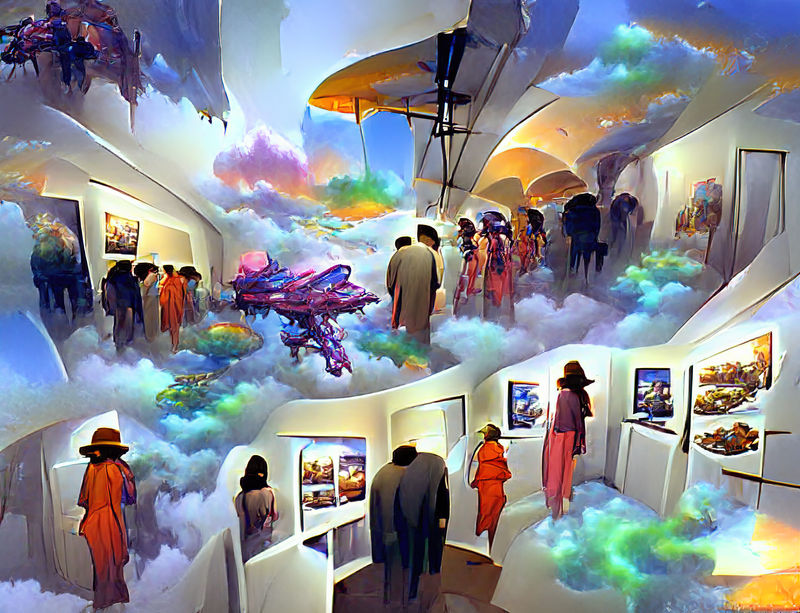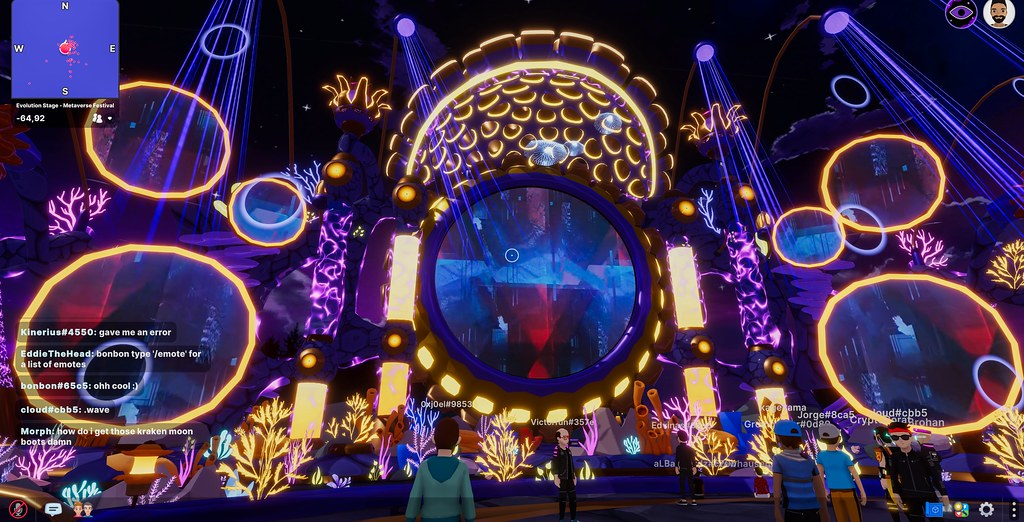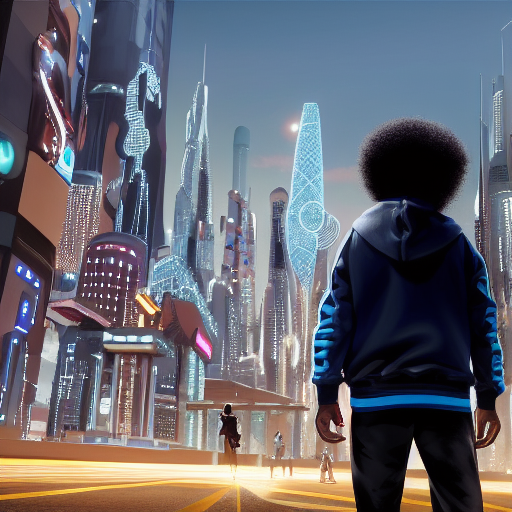
Table of Contents
Introduction to the Metaverse
The concept of the Metaverse has transcended science fiction to become a tangible reality. It represents a collective virtual space where individuals interact with each other and digital environments, blurring the lines between the physical and digital worlds. Understanding the Metaverse’s profound impact requires delving into its definition, tracing its origins, and recognizing its significance in shaping our future.
Definition of the Metaverse
The Metaverse is a concept that refers to a collective virtual shared space, created by the convergence of virtually enhanced physical reality and persistent virtual reality. In this expansive digital realm, individuals can interact with each other and digital objects in real-time, irrespective of physical location. It transcends the boundaries of traditional online platforms, offering immersive and interconnected experiences through various mediums such as augmented reality (AR), virtual reality (VR), and the internet.
The Metaverse fosters socialization, entertainment, commerce, and other activities, blurring the lines between the physical and digital worlds. It serves as a platform for creativity, collaboration, and innovation, with endless possibilities for exploration and development across multiple domains, including gaming, education, healthcare, and beyond. As technology advances and connectivity improves, the Metaverse continues to evolve, presenting new opportunities and challenges for society as a whole.
Brief History and Origins
The concept of the Metaverse has its roots in science fiction literature and early virtual reality research. It gained prominence through Neal Stephenson’s 1992 novel “Snow Crash,” where he depicted a virtual reality-based successor to the internet called the Metaverse. This fictional depiction inspired researchers and developers to explore the possibilities of creating immersive digital environments. The term “Metaverse” itself was coined by author and futurist Vernor Vinge in his 1981 novel “True Names,” describing a collective virtual space where people interact with each other and digital entities.
Throughout the 2000s, virtual worlds like Second Life and online multiplayer games laid the groundwork for the Metaverse, offering early glimpses of interconnected digital spaces. In recent years, advancements in technology, such as augmented reality, virtual reality, blockchain, and artificial intelligence, have fueled the growth of the Metaverse concept. Major tech companies and startups have begun investing in creating their own versions of the Metaverse, aiming to revolutionize how people interact, work, play, and create in digital environments. Today, the Metaverse stands as a vision of a fully immersive and interconnected digital universe, with its history rooted in the imaginative realms of science fiction and the pioneering efforts of virtual reality pioneers and innovators.
Importance of Understanding Its Impact
Understanding the impact of the Metaverse is crucial due to its potential to reshape various aspects of society and daily life. Firstly, it represents a fundamental shift in how people interact with technology, blurring the lines between the physical and digital worlds. As the Metaverse expands, it will influence communication, collaboration, and socialization, offering new ways for individuals to connect and engage with each other globally.
Moreover, the Metaverse has profound implications for industries ranging from entertainment and gaming to education, healthcare, and commerce. It provides opportunities for immersive experiences, innovative learning methods, virtual healthcare solutions, and enhanced online shopping experiences. By understanding these impacts, businesses can adapt and capitalize on the emerging opportunities within the Metaverse, ensuring their relevance in the digital age.
Additionally, the Metaverse raises important considerations regarding privacy, security, and digital rights. As individuals spend more time in virtual environments, questions arise about data protection, identity verification, and virtual property rights. Understanding these implications is crucial for policymakers, regulators, and technologists to establish ethical frameworks and regulations that safeguard users’ rights and ensure responsible development of the Metaverse.
Furthermore, the Metaverse holds the potential to democratize access to information, resources, and opportunities on a global scale. By providing a platform for creativity, collaboration, and innovation, it empowers individuals and communities to participate in the digital economy and contribute to societal progress. However, disparities in access and digital literacy must be addressed to ensure equitable participation and benefits for all.
In conclusion, understanding the impact of the Metaverse is essential for navigating the opportunities and challenges it presents. By embracing its potential while addressing its implications, individuals, businesses, and societies can harness the transformative power of the Metaverse to create a more connected, inclusive, and sustainable future.
The Evolution of Virtual Reality
Virtual reality (VR) serves as the foundation upon which the Metaverse is built. Tracing the evolution of VR provides insights into the technological advancements and innovations that have paved the way for the Metaverse’s emergence.
Early VR Technologies
The late 20th century saw the emergence of early virtual reality (VR) technologies, mostly as a result of military and academic research and development. Filmmaker Morton Heilig developed the Sensorama, one of the first virtual reality devices, in the 1950s. This immersive device incorporated stereoscopic 3D visuals, stereo sound, vibrations, and even smells to create an engaging sensory experience.
In the 1960s and 1970s, Ivan Sutherland and his colleagues at Harvard University developed the Sword of Damocles, considered one of the first head-mounted displays (HMDs). This bulky device suspended from the ceiling allowed users to view simple wireframe graphics in 3D, marking a significant milestone in VR technology.
During the 1980s and 1990s, VR gained momentum with the introduction of commercial VR systems like the Virtuality arcade machines, which offered immersive gaming experiences. Companies such as VPL Research, founded by Jaron Lanier, developed early VR headsets and data gloves, paving the way for interactive virtual environments.
One notable project during this time was the Virtual Reality Modeling Language (VRML), which aimed to create a standard for creating 3D virtual worlds on the internet. Although VRML did not achieve widespread adoption, it laid the groundwork for future developments in web-based VR content.
In the early 21st century, companies like Oculus VR, founded by Palmer Luckey, revitalized interest in VR with the development of high-quality, consumer-grade headsets such as the Oculus Rift. These advancements, coupled with improvements in graphics processing and motion tracking technology, brought VR closer to mainstream adoption.
Overall, early VR technologies laid the foundation for the immersive virtual experiences we see today, shaping the trajectory of VR development and its applications across various industries.

Advancements Leading to the Metaverse
Advancements in technology across multiple domains have been instrumental in shaping the evolution of the Metaverse. One crucial area of progress lies in virtual reality (VR) and augmented reality (AR) technologies. Over the past few decades, significant strides have been made in improving the quality, affordability, and accessibility of VR and AR devices. High-resolution displays, better motion tracking systems, and more intuitive user interfaces have contributed to creating more immersive and realistic virtual experiences.
The development of powerful graphics processing units (GPUs) and advanced rendering techniques has also played a vital role in enhancing the visual fidelity of virtual environments. These improvements enable the creation of stunningly realistic virtual worlds with lifelike textures, lighting effects, and physics simulations, further blurring the lines between the digital and physical realms.
Furthermore, the proliferation of high-speed internet connectivity and cloud computing infrastructure has facilitated seamless online interactions and collaboration within virtual spaces. This has enabled real-time communication, multiplayer gaming, and social experiences on a massive scale, laying the groundwork for interconnected virtual communities within the Metaverse.
The rise of blockchain technology has introduced new possibilities for ownership, authenticity, and interoperability within virtual environments. Non-fungible tokens (NFTs) enable the creation and trade of unique digital assets, such as virtual land, digital artwork, and in-game items, fostering a vibrant digital economy within the Metaverse.
Advancements in artificial intelligence (AI) and natural language processing (NLP) have also contributed to the development of more intelligent and responsive virtual entities within the Metaverse. Virtual assistants, chatbots, and AI-driven NPCs enhance immersion and enable more natural interactions within virtual environments, enriching the overall user experience.
Lastly, the growing interest and investment from major technology companies and startups have accelerated the development of the Metaverse ecosystem. Companies like Meta (formerly Facebook), Epic Games, and Roblox are actively investing in building platforms, tools, and content to support the creation and growth of the Metaverse, driving innovation and adoption in this emerging space.
Key Milestones in VR Development
Key milestones in the development of virtual reality (VR) technology span several decades and have marked significant advancements in hardware, software, and applications. Here are some notable milestones:
- Sensorama (1950s): Filmmaker Morton Heilig creates the Sensorama, one of the earliest attempts at immersive multi-sensory experiences, featuring stereoscopic 3D visuals, stereo sound, vibrations, and even smells.
- Sword of Damocles (1968): Ivan Sutherland and his team at Harvard University develop the “Sword of Damocles,” an early head-mounted display (HMD) that provides a rudimentary form of virtual reality with wireframe graphics.
- Flight simulators (1970s): Flight simulators emerge as one of the first practical applications of VR technology, providing realistic training environments for pilots and astronauts.
- VPL Research (1980s): Jaron Lanier founds VPL Research, which pioneers the development of commercial VR hardware, including the DataGlove and the EyePhone HMD.
- Virtuality arcade machines (1990s): Virtuality introduces arcade machines that offer immersive VR gaming experiences, including multiplayer games and simulations.
- Virtual Reality Modeling Language (VRML) (1994): The development of VRML establishes a standard for creating 3D virtual worlds on the internet, laying the foundation for web-based VR content.
- Nintendo Virtual Boy (1995): Nintendo releases the Virtual Boy, a tabletop VR gaming console that provides stereoscopic 3D visuals. However, it fails to achieve commercial success due to limitations in technology and content.
- Modern VR resurgence (2010s): Advancements in technology, including high-resolution displays, motion tracking sensors, and powerful GPUs, lead to a resurgence of interest in VR. Companies like Oculus VR (acquired by Facebook), HTC, and Sony release consumer-grade VR headsets, such as the Oculus Rift, HTC Vive, and PlayStation VR.
- Oculus Rift Kickstarter (2012): Oculus VR launches a Kickstarter campaign for the Oculus Rift VR headset, raising significant funding and generating widespread excitement for consumer VR.
- Valve Index (2019): Valve releases the Index VR headset, featuring high-resolution displays, precise tracking, and finger-tracking controllers, setting new standards for immersive VR experiences.
These milestones represent significant advancements in VR technology and its applications across various industries, paving the way for the continued growth and innovation in the field of virtual reality.
Components of the Metaverse
At the core of the Metaverse are various components that collectively create a rich and immersive virtual environment. Understanding these components is essential for navigating and leveraging the potential of the Metaverse.
Virtual Worlds and Environments
Digital spaces created and inhabited by users through virtual reality (VR), augmented reality (AR), or other immersive technologies are referred to as virtual worlds and environments.These environments can vary widely in scope, purpose, and design, ranging from realistic simulations of physical spaces to fantastical realms limited only by imagination. Here are some common types of virtual worlds and environments:
- Social Virtual Worlds: Platforms like Second Life, VRChat, and Rec Room provide users with virtual spaces where they can interact with others, socialize, attend events, and engage in various activities. These worlds often feature customizable avatars, user-generated content, and virtual economies.
- Gaming Environments: Video game worlds, such as those found in massively multiplayer online role-playing games (MMORPGs) like World of Warcraft, virtual reality games like Beat Saber, and sandbox games like Minecraft, offer immersive gaming experiences where players can explore, complete quests, build structures, and interact with other players.
- Educational and Training Simulations: Virtual environments are increasingly used for educational purposes, offering simulations and interactive experiences for training, learning, and skill development. Examples include medical simulations for surgical training, flight simulators for pilot training, and virtual laboratories for scientific experiments.
- Virtual Tourism and Exploration: Virtual reality enables users to explore real-world locations and historical sites from the comfort of their homes. Projects like Google Earth VR and VR tourism experiences offer immersive virtual tours of landmarks, cities, natural wonders, and cultural heritage sites around the world.
- Artistic and Creative Spaces: Virtual worlds serve as canvases for artistic expression and creative exploration. Artists and designers use VR tools like Tilt Brush and Quill to create immersive paintings, sculptures, and multimedia experiences, blurring the boundaries between traditional art forms and digital mediums.
- Business and Collaboration Platforms: Virtual environments are increasingly used for remote collaboration, meetings, and events. Platforms like Spatial and AltspaceVR offer virtual meeting spaces where users can collaborate, share documents, and interact with colleagues and clients in a virtual setting.
These examples illustrate the diverse range of virtual worlds and environments that exist today, each offering unique opportunities for exploration, interaction, and immersion in digital spaces. As technology continues to evolve, the boundaries between the physical and virtual worlds will continue to blur, opening up new possibilities for creativity, communication, and collaboration.

Avatars and Identities
Avatars serve as digital representations of users within the Metaverse. They allow individuals to express themselves, customize their appearance, and interact with others in a virtual space. Avatars play a crucial role in shaping social interactions and identity within the Metaverse.
Social Interactions and Communities
One of the defining features of the Metaverse is its emphasis on social interactions and communities. Users can connect with friends, join interest-based groups, and participate in virtual events and activities. The sense of presence and camaraderie fostered within these virtual communities is akin to real-world interactions.
Applications and Industries
The Metaverse has implications across various industries and sectors, revolutionizing how we work, play, and learn. Examining its applications provides insights into its transformative potential.
Gaming and Entertainment
Gaming has long been at the forefront of virtual experiences, and the Metaverse amplifies this by offering immersive, interactive worlds for players to explore. From massive multiplayer online games to virtual concerts and events, the Metaverse has redefined entertainment in the digital age.
Education and Training
In the realm of education, the Metaverse offers innovative solutions for learning and skill development. Virtual classrooms, interactive simulations, and immersive experiences enable educators to engage students in new and exciting ways, transcending traditional boundaries of time and space.
Business and Commerce
Businesses are increasingly leveraging the Metaverse for marketing, sales, and collaboration. Virtual storefronts, immersive product demonstrations, and virtual meetings enable companies to reach global audiences and streamline operations in ways previously unimaginable.
Challenges and Concerns
While the Metaverse holds immense promise, it also presents various challenges and concerns that must be addressed to ensure its responsible and ethical development.
Privacy and Security Issues
The immersive nature of the Metaverse raises concerns about privacy and data security. As users spend more time in virtual environments, safeguarding personal information and preventing unauthorized access become paramount.
Digital Inequality
Access to the Metaverse is not equitable, with disparities in hardware, internet connectivity, and technical literacy creating barriers for marginalized communities. Bridging the digital divide is essential to ensure that the benefits of the Metaverse are accessible to all.
Ethical Implications
The Metaverse blurs the line between reality and simulation, raising ethical questions about identity, consent, and behavior. Addressing these ethical implications requires thoughtful consideration and proactive measures to uphold integrity and respect within virtual spaces.
The Future of the Metaverse
Looking ahead, the Metaverse holds boundless potential to reshape our reality in ways we are only beginning to imagine. Predicting its trajectory and potential outcomes offers glimpses into a future where the physical and digital worlds converge seamlessly.
Predictions and Possibilities
Experts envision a future where the Metaverse becomes an integral part of everyday life, seamlessly integrated into our social, professional, and recreational activities. From virtual workspaces to immersive storytelling experiences, the possibilities are endless.
Integration into Daily Life
As the Metaverse continues to evolve, its integration into daily life will become increasingly seamless. From virtual meetings and social gatherings to shopping and entertainment, the lines between the physical and digital realms will blur, enhancing convenience and connectivity.
Potential Benefits and Drawbacks
While the Metaverse offers numerous benefits, it also poses challenges and drawbacks that must be addressed. From fostering global collaboration to exacerbating digital divides, understanding the nuances of its impact is essential for informed decision-making.
Conclusion
In conclusion, the Metaverse represents a paradigm shift in how we perceive and interact with digital technologies. Its emergence signals a future where the boundaries between the physical and digital worlds dissolve, ushering in new opportunities and challenges alike. By embracing the potential of the Metaverse while addressing its complexities, we can shape a more inclusive, equitable, and immersive reality for generations to come.
Unique FAQs
- What distinguishes the Metaverse from virtual reality? The Metaverse encompasses a vast, interconnected network of virtual environments and social interactions, whereas virtual reality typically refers to immersive experiences within a singular virtual space.
- How will the Metaverse impact traditional industries such as retail and tourism? The Metaverse has the potential to revolutionize traditional industries by offering immersive shopping experiences, virtual tourism opportunities, and innovative marketing strategies.
- Are there concerns about addiction and overreliance on the Metaverse? Like any technology, the Metaverse raises concerns about addiction and excessive use. It’s essential to promote healthy digital habits and balance virtual experiences with real-world interactions.
- What role will artificial intelligence play in shaping the Metaverse? Artificial intelligence will play a crucial role in shaping the Metaverse by powering virtual assistants, personalized experiences, and dynamic content generation.
- How can policymakers ensure the responsible development of the Metaverse? Policymakers must collaborate with industry stakeholders to establish regulations and standards that protect user privacy, promote inclusivity, and mitigate potential risks associated with the Metaverse.









